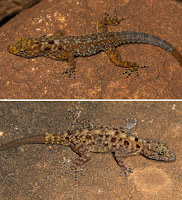 |
| Cnemaspis ganeshaiahi Narayanan, Pal, Grismer & Aravind, 2023 |
Abstract
We describe a new species of rupicolous Cnemaspis from the Male Mahadeshwara Wildlife Sanctuary in the Eastern Ghats. The current description is based on a type series of eight specimens that bear a unique combination of morphological and colour pattern characteristics that do not occur in other closely related species. Maximum likelihood and Bayesian analyses based on the mitochondrial gene ND2 recovered the new species to be nested within the gracilis clade and the sister species to the recently described C. agarwali from the Eastern Ghats.
Keywords: Endemic, gecko, India, integrative taxonomy, MM Hills, morphology
 |
| Live images of Cnemaspis ganeshaiahi sp. nov. A Paratype (BNHS 3148), B live uncollected female. |
Cnemaspis ganeshaiahi sp. nov.
Suggested common name: Ganeshaiah’s dwarf gecko.
Diagnosis: A small-sized Cnemaspis, SVL up to 32.8 mm (n = 8). Dorsal pholidosis heterogeneous; weakly keeled granular scales intermixed with fairly regularly arranged rows of enlarged, strongly keeled, conical tubercles; last one or two rows of enlarged tubercles on flank keeled, spine-like; 12–14 rows of dorsal tubercles at mid-body, 14–18 tubercles in paravertebral rows, paravertebral rows rarely irregularly arranged; ventral scales smooth, subcircular, subimbricate, subequal from chest to vent, 24–28 scales across belly at mid-body, 118–124 longitudinal scales from mental to cloaca; subdigital scansors smooth, unpaired, unnotched; nine or 10 lamellae under digit I of manus and pes, 15–18 lamellae under digit IV of manus and 17–21 lamellae under digit IV of pes; males (n = 5/8) with five femoral pores on each thigh separated by seven or eight poreless scales from series of four to six precloacal pores, precloacal pores separated medially by one or two poreless scales, (precloacal pores rarely not separated, n = 1/5); tail with enlarged, strongly keeled, pointed, and spine-like tubercles forming whorls; median row of subcaudals smooth, roughly pentagonal, and distinctly enlarged. Dorsum pale-orange, mottled with small white to light-grey spots and few small black spots with a series of light-grey vertebral blotches extending from neck to tail base; a single central black dorsal ocellus on neck and a smaller one on occiput separated by a light-grey blotch, ocellus on neck flanked anteriorly on each side by a subequal ocellus and posteriorly by a pair of obscure blotches; venter off-white with black speckles, two distinct pairs of black streaks on throat; original tail in males pale-grey, regenerated tail orange-brown.
Etymology: The specific epithet of this new species is a patronym in honour of Professor K.N. Ganeshaiah, who served as a Professor of Plant Genetics and Breeding at the University of Agricultural Sciences, Bangalore, and was a founding trustee of the Ashoka Trust for Research in Ecology and the Environment (ATREE), Bangalore. Professor Ganeshaiah has contributed significantly towards plant breeding, ecology, evolutionary biology, and conservation biology. He also popularised science literature in the local language and wrote over 25 books.
Surya Narayanan, Saunak Pal, L. Lee Grismer and N. A. Aravind. 2023. A New Species of Rupicolous Cnemaspis Strauch, 1887 (Squamata: Gekkonidae) from the Male Mahadeshwara Wildlife Sanctuary, southern Eastern Ghats, India. Vertebrate Zoology. 73: 189-203. DOI: 10.3897/vz.73.e101311

